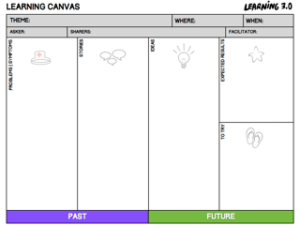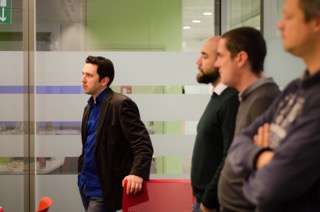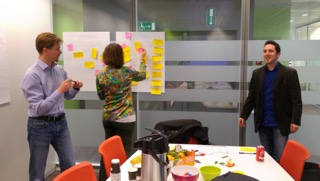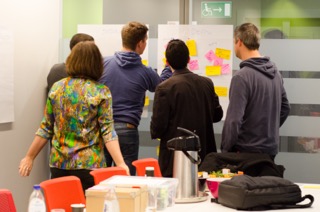by Simone Mosena
Every year, I like to attend training workshops and conferences. In addition to growing my experience and knowledge, it stimulates my creativity. When the conference is good, it also stimulates moments of inspiration. I usually return to work with lot of new ideas and insights.
Last year, while at Dare Devils, I had the opportunity to attend Jason Little’s, Lean Change Management training. It was such a great investment of my time!
Amongst other things, Jason uses canvas to align different points of view. He argues that using a canvas:
- Facilitates a conversation
- Captures the output
- Makes it visible
We tried a few different canvas models during our training and Jason mentioned a few others that he had experimented with. One of them in particular caught my attention: The Learning Canvas. The reason I particularly liked this model was its simplicity. In addition, the canvas creator, Alexandre Magno, is a Brazilian just like myself!
I googled a bit more about the Learning Canvas and its origins and found it is part of the Learning 3.0 model.
During preparation for the first workshop that I would personally facilitate, I looked for a canvas that would work to help us work through changes in my company Arexo Consulting. When I discovered Learning Canvas, I felt I had found the ideal model for our situation. Our way of working is to allow all members of the company to collaborate, express their ideas, and help individuals and teams feel happier at work.
Arexo is a Belgian IT company specialized in software development and team/project management. We provide training, coaching, consulting services, and we also create mobile & web applications. Our team is composed of very skilled people.
Why I chose the Learning Canvas?
It’s purpose is to fix real problems, through mutual group learning, and that’s just what we need to achieve.
It has many benefits, such as:
- It blurs the difference between experienced individuals and not so experienced individuals. This avoids the experts being able to run the show
- It allows everyone to express themselves, even the shy guys!
- It gives equal importance to past experiences and new ideas
Here’s how our company used the Learning Canvas during our first training session.
Experience Learning Canvas at Arexo
Like most companies, we would love to increase our visibility quotient; having more people knowing who we are and what we do. This is actually one of the company objectives for 2016. Actually this is an OKR.
This objective had been addressed in the past, with very mixed results. This time we were looking for a new approach: a collaborative one, that fostered individual engagement. This is a huge subject that can be developed in many ways. We tried to learn with our team, using Learning Canvas as an alignment tool.
How we used Learning Canvas?

We started the session explaining the context, the expectation we had with the workshop and I took the role of facilitator, explaining the canvas and the steps of the process.
The subject of our discussion was complexed. You could sense the surprise amongst the team when we presented our choice of canvas. One of the team commented that it was too simple, but we were all willing to contribute and the session started off with everyone in a good mood and happy to be participating.
Why did we choose the Learning Canvas, over a simple brainstorming session?
Brainstorming sessions without a structured framework tend to be inefficient. Ideas burst from the most expressive people, or the subject experts. In this session we wanted everyone to contribute and commit.
We followed all the steps proposed by Alexandre Magno in Learning 3.0, but used some of our own adaptations, to fit the context.
Step 1: Describe theme, problems and symptoms

Someone needs to present the problem. Our CEO took the role of the asker. He explained the theme of our discussion. He listed some problems and symptoms that he knew about.
The concern affected everyone in the company. We asked all participants to share the problems they saw as being related to the issue. Each one collaborated with new elements. Our scenario became more complete and richer. This allowed us to better understand the concern.
Step 2: Elaborate the ideal vision
Together we created our ideal vision. A vision we could share and one that would allow us to arrive to a common goal. It was the discussion within the discussion. It helped us to align people’s needs and understand how far they were willing to go with a bigger visibility quotient. We shared our vision.
What could we do to help us get there? Talks? Articles? Promotional items?
In the processes of constructing the ideal vision we had a lot of insights. We created a list of possible actions and we asked all participants to vote and to choose their top three topics.
We took one of them as an example: Promotional Items. We then delved deeper into this subject.
- What were the best products to represent our company?
- What were the best products in line with the values of the company from the standpoint of our people
- would our people be willing to use these products?
Step 3: Share past experiences and/or share ideas
We limited the canvas to two experiences/ideas per person, in order to give everyone a chance to speak.
We asked the participants, not only to share successful experiences, but also unsuccessful ones. Why? In order to avoid falling into the same traps. Arexo had already created promotional items in the past, which hadn’t had the expected outcome.
Why did we decide to mix past experiences and ideas?

We decided that this would allow everyone to contribute, even if they had no experience. Everybody had the opportunity to discuss his experiences.
While participants spoke, the post-its were organized by theme, by our facilitator.
After the first round, we organized a second brainstorming to figure out if our shared thoughts were enough to create new ideas. The answer was positive. New ideas popped into our canvas.
The canvas stopped here. But we created a new step in order to make it concrete and actionable.
Step 4: Create an Action Plan

When the tour ended, we asked the participants to vote on their top three ideas. Those which had a better chance of success and higher ROI. We made a short actions list for each of them and asked for volunteers to perform the actions.
Conclusion? Mission accomplished!
The canvas worked and all of us collaborated to find the right product. One of the team commented that ‘Learning Canvas’ is a very imposing name for such a simple tool. It’s simple to use and efficient. It allowed us to stay focused on our problem, not on the method or the canvas.
Personally for me, it was an incredibly rich experience. It was amazing to learn together as a group.
Header Image: Tim Gouw (Unsplash)


Hi Simone, thanks for sharing this interesting story about Learning 3.0 at Arexo! It’s really great to see companies using the Learning Canvas, and other Learning 3.0 practices, to achieve better results of their meetings and all kind of learning experiences. 😉